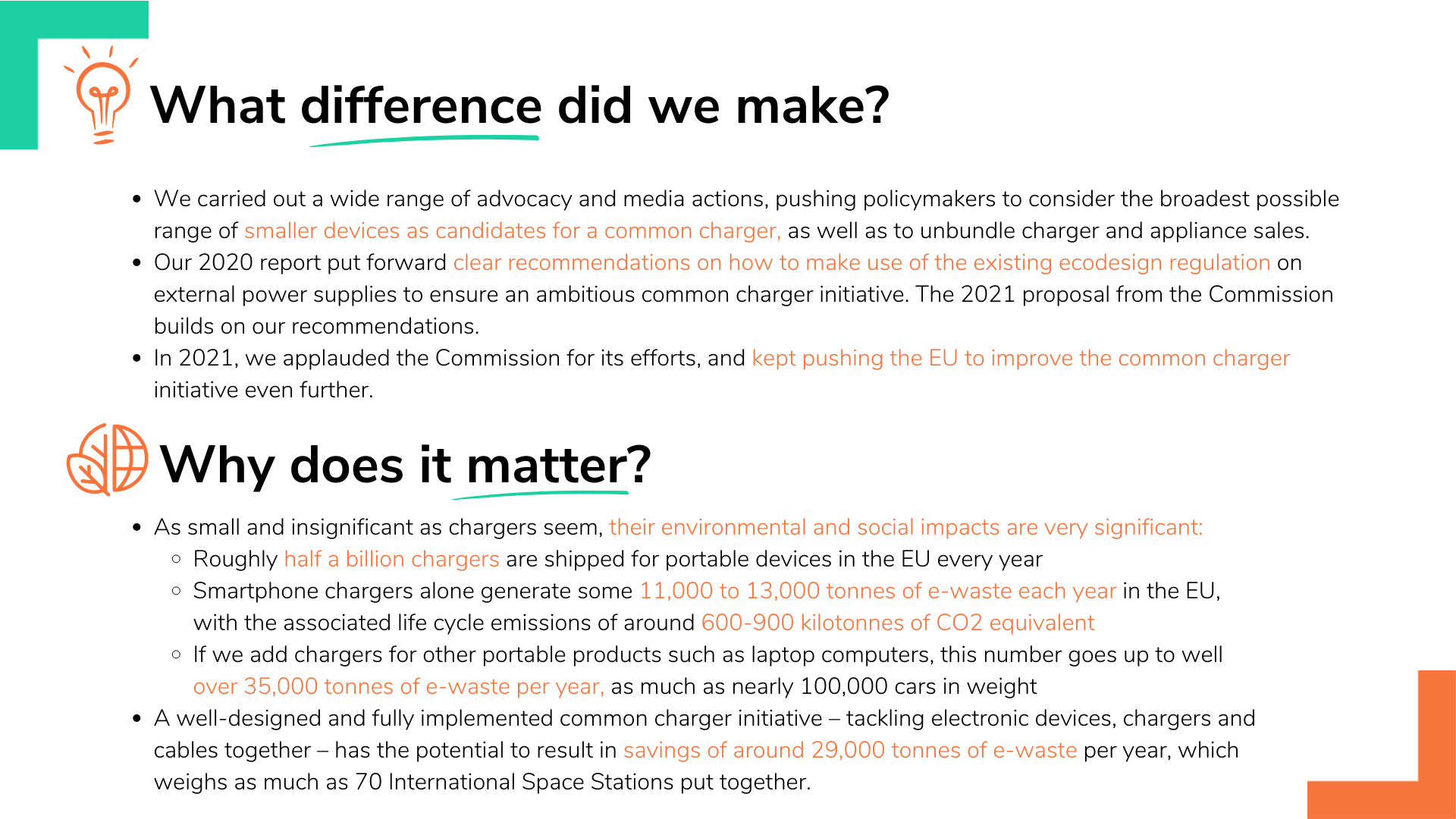One charger to fit them all
In 2021, the European Commission unveiled its long-awaited proposal for a common charger for electronic devices. Strongly opposed by powerful market players, this initiative would not have been possible without consistent and vocal support from ECOS and the wider environmental NGO community.
A first attempt at untangling the charger problem
Most of us have it at home, and most of us ignore it: the infamous drawer full of tangled charging cables. The balled-up mess stays with us for years on end, with every new purchase adding to the pile.
Over 10 years ago, EU policymakers decided it was time to address both the waste impacts and consumer inconvenience caused by proliferating chargers and cables. To do this, the European Commission requested that mobile phone manufacturers introduce a voluntary initiative to harmonise their charging approaches. As a result, a number of companies signed a Memorandum of Understanding (MoU) in 2009, in which they committed to harmonising chargers for smartphones placed on the EU market from 2011 onwards.
The MoU, which expired in 2014, brought about a reduction in the number of charging solutions – the market was down to three main connectors still in use today: USB micro-B, USB-C and the proprietary Lightning connector. Approximately 75% of the market has shifted to standardised USB connectors on their smartphones. However, despite this apparent success, some manufacturers profited from the continued use of proprietary connectors through the sales of cables, adaptors and licensing. What is more, around a quarter of smartphone cables today remain non-interchangeable, and the design of chargers and connectors for other portable products also tends to vary.
Taking charge of chargers
Ever since the MoU expired in 2014, the European Commission has been urged to take action on the continued lack of interoperability of chargers. In January 2020, the European Parliament called on the Commission to introduce a common charger ‘as a matter of urgency in order to avoid further internal market fragmentation’. Our own asks, articulated in early 2019, were finally getting traction. As a direct reaction to these calls, in its 2020 Work Programme the European Commission announced a legislative proposal on a common charger for ‘smartphones and similar devices’.
Initially, the regulator focused on the Radio Equipment Directive of 2014, which already contained certain provisions allowing for secondary legislation on the issue, although with a highly limited scope. The Commission was risking a patchwork solution, which would only target a limited number of products, and address only charging ports.
At ECOS, we saw the game changing potential of the initiative – and we made sure policymakers saw it too. We urged the Commission to tackle the issue comprehensively by looking at the broadest possible range of smaller devices, consumer information aspects, interoperability of fast charging functions and the unbundling of the default sales of devices with chargers. In July 2020, our dedicated report put forward a clear path to a fully implemented, ambitious common charger initiative, which could bring about substantial savings:
We engaged with MEPs and policy makers, but also mobilised press and partners, making sure that our voice was widely heard.
At last, in September 2021, the European Commission finally delivered, and it was time to closely examine the long-overdue common charger initiative. Is it perfect? No. As any other piece of legislation, it can still be improved. But the fact that it was published will greatly reduce e-waste and make our lives… less messy.
USB-C, interoperability and no more charging for the charger
Notably, the Commission proposed a review of the Radio Equipment Directive, including the following highlights:
- Making USB-C connectors mandatory for smartphones, tablets, cameras, headphones, portable speakers and handheld videogame consoles;
- Harmonisation of fast charging technology making USB-C power delivery protocol mandatory (to ensure that devices can be used with chargers with different power ratings);
- Making an unbundled sales option obligatory – devices will be available without chargers included in the box;
- Informing consumers about the supported power rating of the charger.
We are thrilled to see that the 2021 proposal covers a much broader range of aspects than just charging ports on ‘smartphones and similar devices’. The increased ambition, showing the EU’s will not to bow to pressure from large companies, is exactly what ECOS hoped for.
A positive report
The draft report on the common charger proposal by the European Parliament’s internal market committee was published in January 2022. It builds on many of the suggestions we made in our recent position paper, and suggests a number of corresponding improvements in the following areas:
- On wireless charging the rapporteur has proposed a clearer timeline for the complete introduction of standards on interoperability
- The scope is proposed to be significantly extended, including all three categories of products ECOS advocated for
- Unbundling is proposed to be made the default sales option (as per ECOS’s fall-back proposal)
- Consumer information is proposed to be improved by introducing clearer marking on power ratings (i.e. not only maximum, but also minimum and fast speed ratings supported by the device)
- Circumvention clause is proposed as requested in our paper
- Shorter entry into force is proposed as suggested in our paper
Next steps?
We are now awaiting an additional proposal to review the ecodesign regulation on external power supplies, which is meant to address compatibility issues at the level of the charger (as opposed to the device itself). We have also made a range of recommendations on how to strengthen the Commission’s proposal, and bring the initiative to its full potential.



